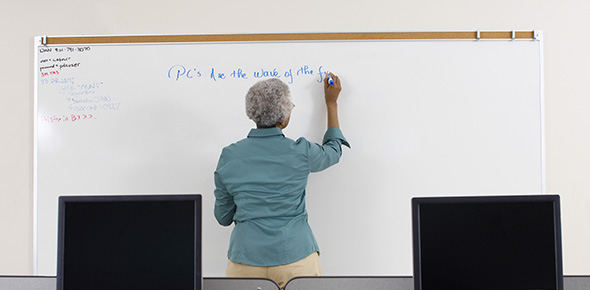Related Flashcards
Cards In This Set
| Front | Back |
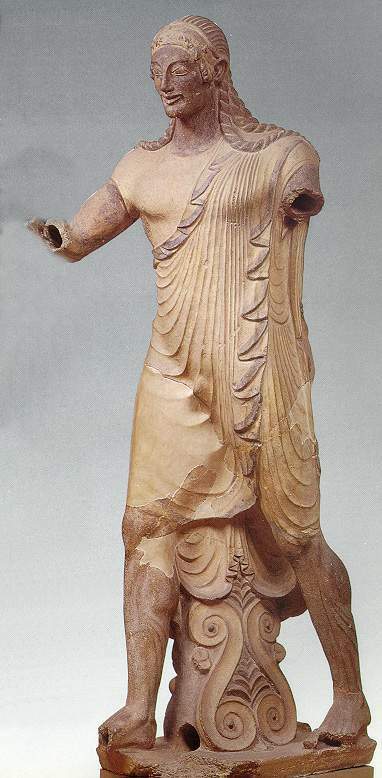 9-4, the Veii Apollo. Know culture, date site material where placed what Greek style it is related to what it shares with Greek art how it differs |
9-4, the Veii Apollo.
Know culture, (Etruscan)
date (c. 500 BCE or Archaic),
site (Veii),
material (terracotta),
where placed (on roof of temple),
what Greek style it is related to (Archaic),
what it shares with Greek art (naturalism, shape of
face and
hair, Archaic smile),
how it differs (god is shown clothed, striding
posture is
more dynamic, material for architectural sculpture)
|
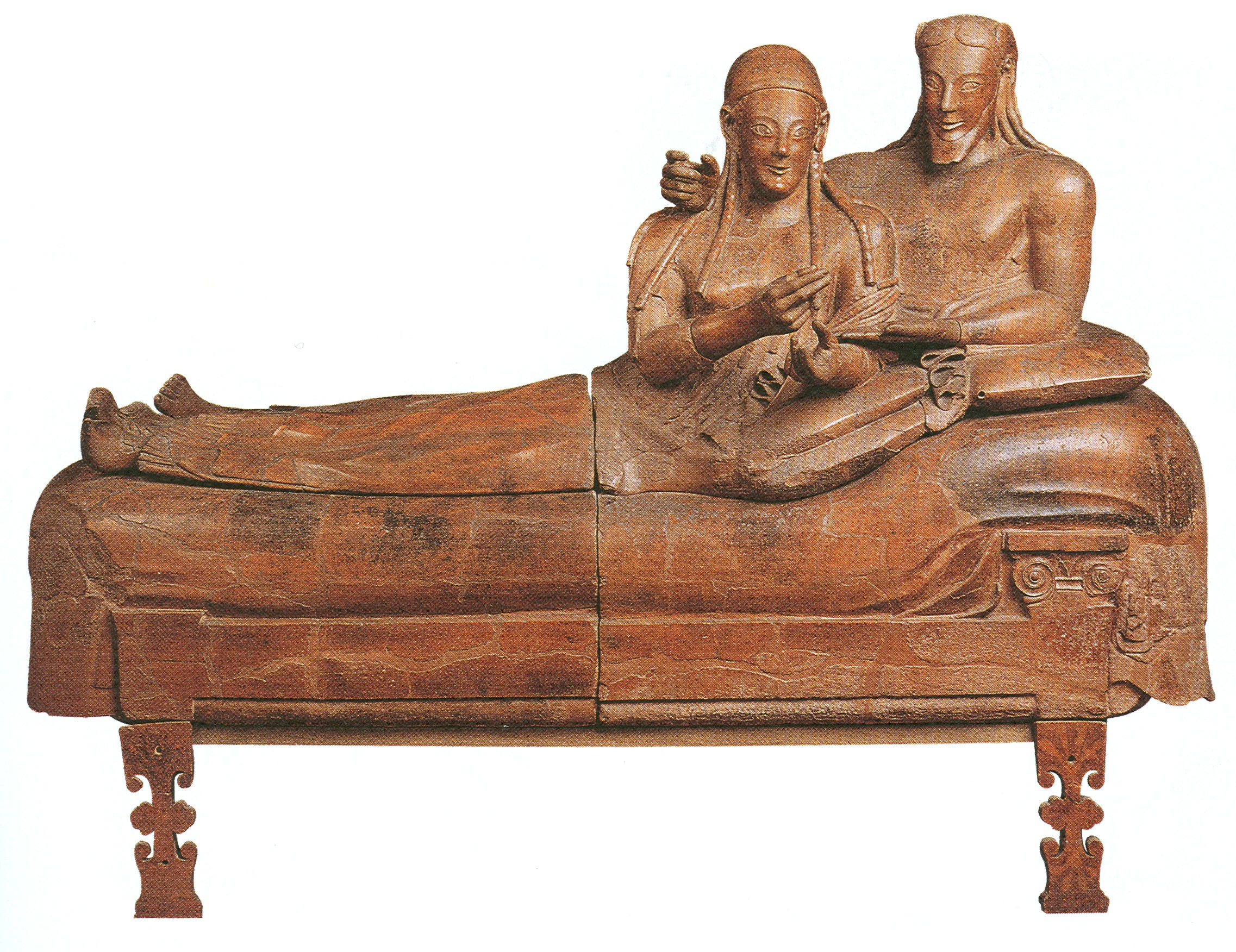 9-5, The Sarcophagus of the Married Couple. Know site date material what represents how differs from Greek practices what man might have held in his hand what that might have symbolized |
9-5, The Sarcophagus of the Married Couple.
Know site (Cerveteri),
date (again can use Archaic instead of year),
material (terracotta),
what represents (man and woman on couch at
symposium/banquet),
how differs from Greek practices (women never
allowed at
greek banquets),
what man might have held in his hand (egg),
what that might have symbolized (cult of Orpheus,
idea of
cosmic egg, and rebirth)
|
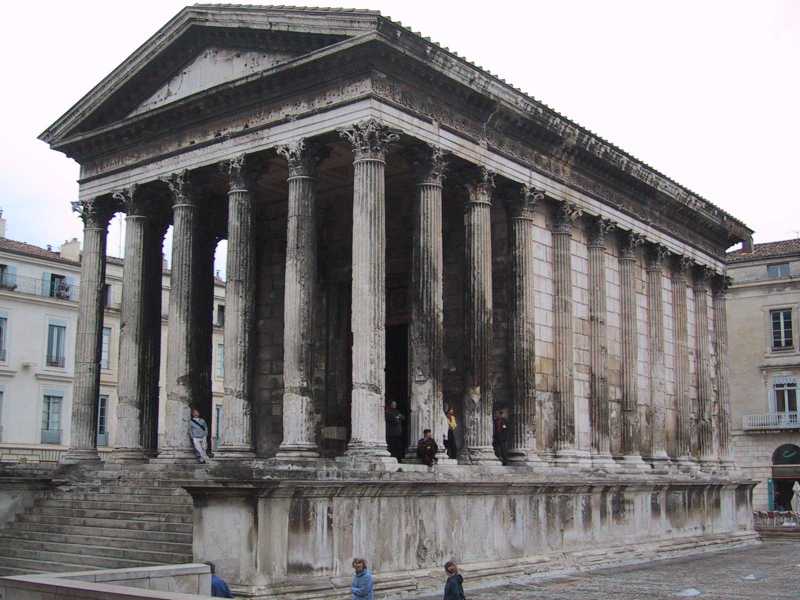 10-32, Maison Carree. Know culture, date, where built emperor who dedicated it to whom it was dedicated how this semiperipteral Roman temple differs from a Greek peripteral temple what culture the podium and practice of confining columns to the porch came from what order this is |
10-32, Maison Carree.
Know culture, (Roman)
date, (Early Empire)
where built (Nimes, France),
emperor who dedicated it (Augustus) and
to whom it was dedicated (young relatives who were
appointed
as heirs but died prematurely),
how this semiperipteral Roman temple differs from a
Greek
peripteral temple (engaged columns on three sides, freestanding columns
only on
porch, podium),
what culture the podium and practice of confining
columns to
the porch came from (Etruscan),
what order this is (Corinthian)
|
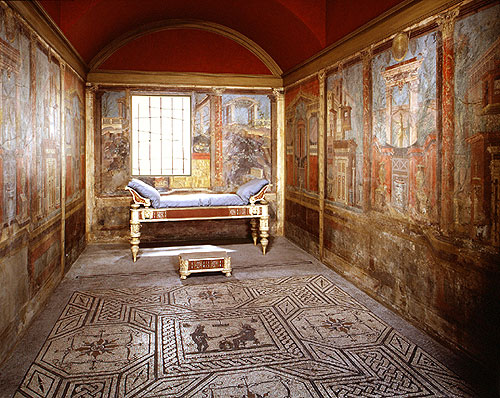 10-19, paintings in the Synistor House. Know culture, date, name of owner of house, why these paintings are so well-preserved what they show what types of buildings are most frequently represented in his house and what they indicate about owner’s interests type of perspective used by artist why Synistor may have had these paintings done in his house |
10-19, paintings in the Synistor House.
Know culture, (Roman)
date, (Early Empire)
name of owner of house, (Publius Fannius Synistor)
why these paintings are so well-preserved (buried
by ash and
pumice from Vesuvius),
what they show (architectural scenes),
what types of buildings are most frequently
represented in
his house and what they indicate about owner’s interests (temples to
night
goddesses, theaters),
type of perspective used by artist (intuitive
perspective/use of receding diagonal lines),
why Synistor may have had these paintings done in
his house
|
|
10-52, Hadrian’s Villa at Tivoli. Know culture, date, emperor, his love of Greek culture, what this palace contained what part of the empire this section represents why this province was significant for Hadrian where architectural design and originals for statues came from how Hadrian repaid Greeks for taking their art |
10-52, Hadrian’s Villa at Tivoli.
Know culture, (Roman)
date, (High Empire)
emperor, (Hadrian)
his love of Greek culture,
what this palace contained (miniaturized versions
of great
architecture from around the empire),
what part of the empire this section represents
(Egypt,
specifically Alexandria),
why this province was significant for Hadrian (his
lover
Antinuos committed suicide there and was deified by Hadrian),
where architectural design and originals for
statues came
from (Greece),
how Hadrian repaid Greeks for taking their art
(built public
facilities and infrastructure for Athens)
|
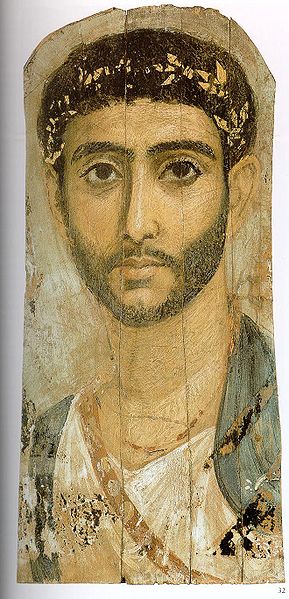 10-62, Fayum mummy portrait (not this one but one very similar). Know date, where found technique sequence of how these were used lasting feature of Roman art they reflect what later Byzantine Christian art form these may have inspired |
10-62, Fayum mummy portrait (not this one but one
very
similar).
Know date, (High Empire)
where found (Fayum oasis, Egypt),
technique (encaustic paint on wooden panels),
sequence of how these were used (painted and placed
in house
during person’s life, attached to the mummy and kept in house for
ancestor
worship after their death, finally buried),
lasting feature of Roman art they reflect (interest
in
individual portraiture, related to ancestor worship),
what later Byzantine Christian art form these may
have
inspired (icons)
|
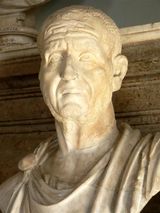 10-68, bust of Trajan Decius. Know culture, date, emperor, what this period of the Late Empire was called and why, how this portrait differs from previous imperial portraits how this reflects the events of the period and what happened to emperor |
10-68, bust of Trajan Decius.
Know culture, (Roman)
date, (250 CE or Late Empire)
emperor, (Trajan Decius)
what this period of the Late Empire was called
(Barracks
Emperors) and why,
how this portrait differs from previous imperial
portraits
(anxious, scared, tired look),
how this reflects the events of the period (empire
suffered economic
crisis, military defeats, political instability and plague) and
what happened to emperor (having stolen the throne
himself,
he was killed in battle)
|
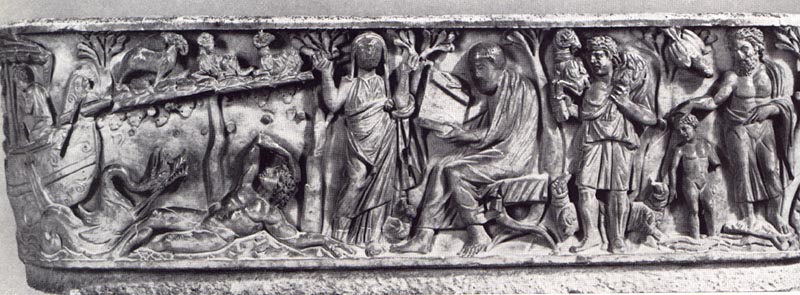 11-6, Sarcophagus from Santa Maria Antiqua, Rome. Know function, date city, identity of figures for the Christian owner and how a pagan would have interpreted them why the need for unclear images |
11-6, Sarcophagus from Santa Maria Antiqua, Rome.
Know function, (served as portraits of the
deceased)
date (c 270 CE or Early Christian or Late Empire),
city, (Santa Maria Antiqua)
identity of figures for the Christian owner (Jonah
and the
sea monster, orant at center, Christian teacher with scroll, Good
Shepherd,
baptism) and
how a pagan would have interpreted them
(Jonah=Endymion,
philosopher with scroll, Good Shepherd=Apollo or Hermes),
why the need for unclear images (so could be
understood by
Christians but not recognized as Christian by the authorities since
Christianity was still illegal)
|
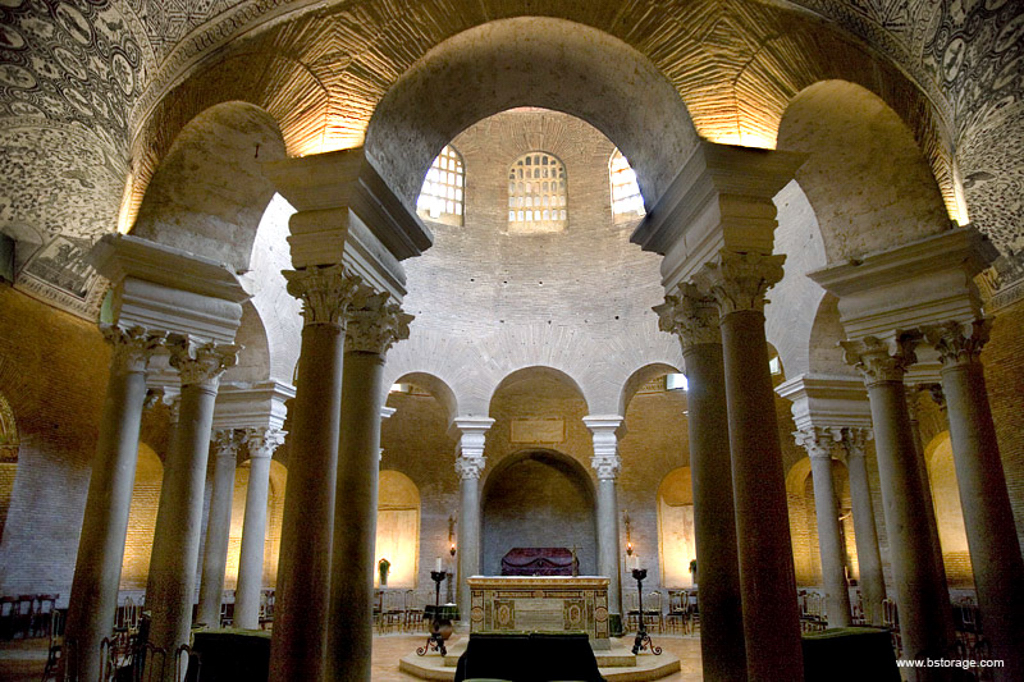 11-11, Church of Santa Costanza/Constantina, Rome. Know date, city, religion of Costanza/Constantina, whose daughter she was, that she is buried here, type of building used for this church why traditional Greco-Roman peripteral/semiperipteral temples weren’t adopted for Christian worship name for type of walkway around a rotunda church |
11-11, Church of Santa Costanza/Constantina, Rome.
Know date, (Late Empire or Early Christian)
city, (Santa
Costanza)
religion of Costanza/Constantina,
whose daughter she was, (Constantine’s)
that she is buried here,
type of building used for this church (rotunda,
rather than
basilica),
why traditional Greco-Roman
peripteral/semiperipteral
temples weren’t adopted for Christian worship (too small for mass public
worship),
name for type of walkway around a rotunda church
(ambulatory)
|
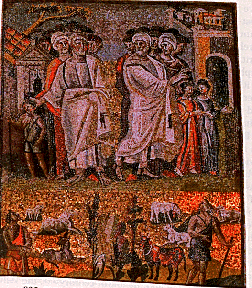 11-14, Mosaic of the Parting of Abraham and Lot from Sta. Maria Maggiore, Rome. Know church, date city, what biblical figures are shown, what scene symbolizes what occupies center of composition and why what style is reflected in details of clothing and architectural background what new materials were used for mosaics in the Early Christian period purpose of mosaics and other church decorations |
11-14, Mosaic of the Parting of Abraham and Lot
from Sta.
Maria Maggiore, Rome.
Know church, date (5th century or Early
Christian
OK),
city, (Santa Maria Maggiore)
what biblical figures are shown, (Abraham and Lot)
what scene symbolizes (choice between good and
evil),
what occupies center of composition (gap between
the two
groups of figures)
and why (to emphasize the action of parting or
separation),
what style is reflected in details of clothing and
architectural background (Classical Greek/Roman),
what new materials were used for mosaics in the
Early
Christian period (gold, colored glass),
purpose of mosaics and other church decorations
(gift to
God, religious education for the illiterate)
|
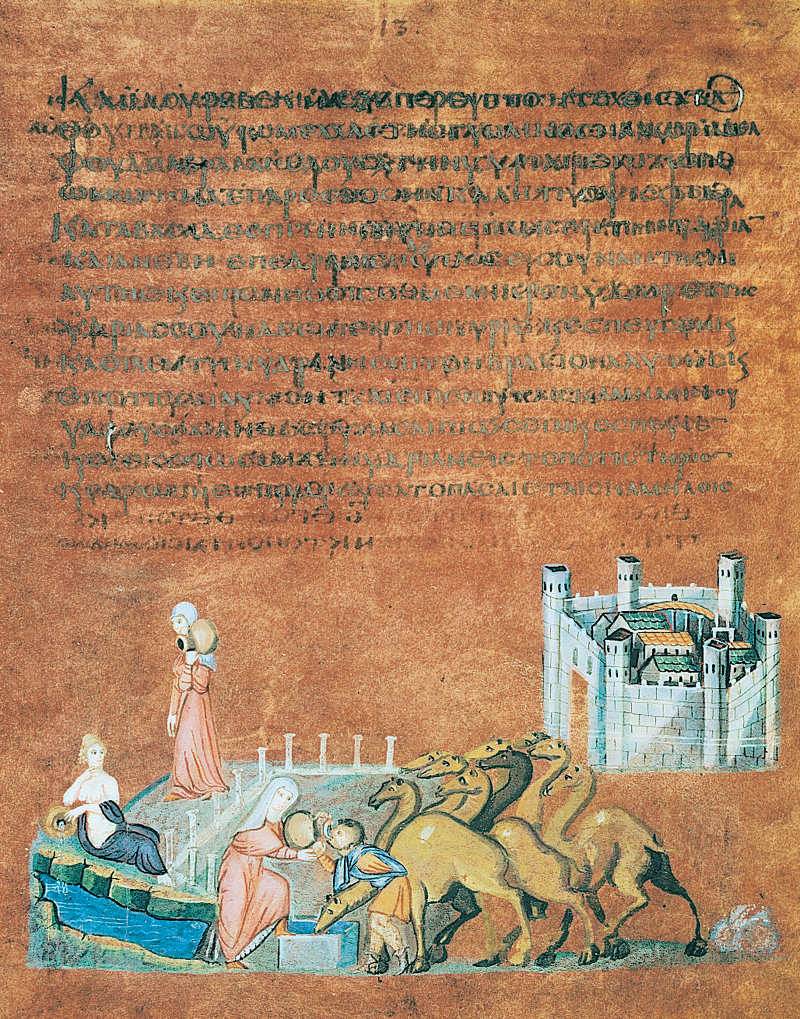 11-19, Rebecca at the Well from the Vienna Genesis. what it is made of date features of Late Roman art it still uses term used for medieval painted books in general |
11-19, Rebecca at the Well from the Vienna
Genesis.
what it is made of (parchment, calf hide),
date (500-550 or Early Christian),
features of Late Roman art it still uses (repeating
figure
of same character doing different actions to show story over time,
female water
spirit in well),
term used for medieval painted books in general
(illuminated
manuscripts)
|
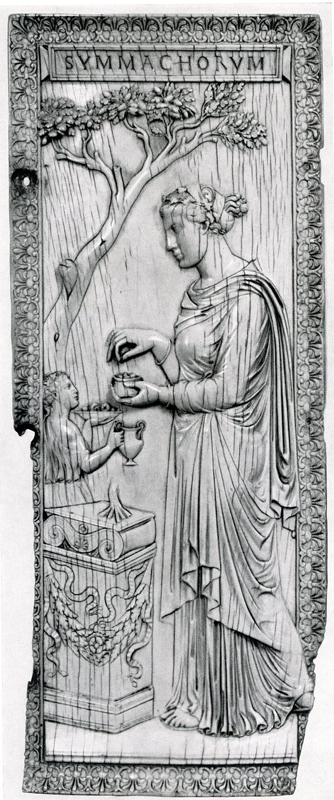 11-23, Diptych of the Symmachi/Nicomachi. Know date material type of object this is original purpose what used for later who the Symmachi and Nicomachi were what this diptych commemorates although this is made when empire is Christian, this is a pagan piece; what god’s rituals seem to be referred to in the scene |
11-23, Diptych of the Symmachi/Nicomachi.
Know date (c. 390 CE or Late Antiquity),
material (ivory),
type of object this is (diptych—CAREFUL),
original purpose (writing tablet),
what used for later (gifts and decorations for
churches),
who the Symmachi and Nicomachi were (elite Roman
families),
what this diptych commemorates (marriage between
them),
although this is made when empire is Christian,
this is a
pagan piece;
what god’s rituals seem to be referred to in the
scene
(Bacchus/Dionysius)
|
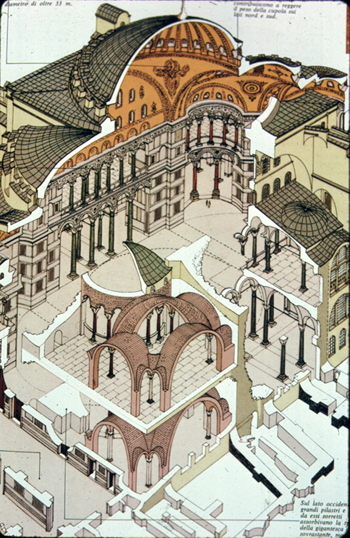 12-3, Hagia Sophia. city dates emperor “architects” and what they were trained as who the church was dedicated to what building it was made to copy and outdo what types of Roman buildings it combines how the roof of the rectangular building used round shapes name for the triangular vaults that reinforce the dome |
12-3, Hagia Sophia.
city (Constantinople),
dates (532-537, Early Byzantine, or just
Byzantine),
emperor (Justinian),
“architects” (Anthemius of Tralles and Isidodorus
of
Miletus) and
what they were trained as (mathematicians),
who the church was dedicated to (the Wisdom of God,
Christ),
what building it was made to copy and outdo
(Solomon’s
Temple in Jerusalem),
what types of Roman buildings it combines
(basilica,
rotunda),
how the roof of the rectangular building used round
shapes
(dome combined with two hemidomes),
name for the triangular vaults that reinforce the
dome
(pendentives)
|
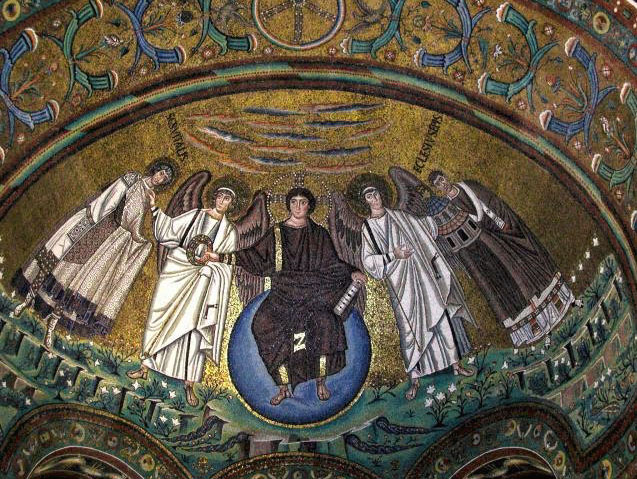 12-9, Apse in Church of San Vitale, Ravenna. Know date, city, country, art tradition emperor what mosaic represents why Ecclesius is holding a model of the church |
12-9, Apse in Church of San Vitale, Ravenna.
Know date, (Bysantine)
city, (San Vitale)
country, (Ravenna)
art tradition (Byzantine),
emperor (Justinian),
what mosaic represents (Christ, as beardless Roman
emperor,
sitting on orb representing universe, restoring Eden and opening scroll
of
judgment at end of the world, with angels and St. Vitale on the left and
Ecclesius, the bishop who built the church on the right),
why Ecclesius is holding a model of the church (he
is
dedicating it to God)
|
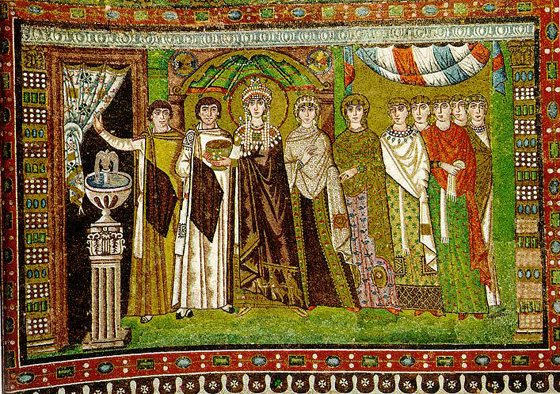 12-11, Mosaic from San Vitale showing Theodora. Know city, date, empress, art tradition, purpose of mosaic why empress is in the center what Theodora is doing what design on her dress represents what religious figure her image is designed to look like what the processions are facing and what this represents |
12-11, Mosaic from San Vitale showing Theodora.
Know city, (San Vitale)
date, (Byzantine)
empress, (Theodora)
art tradition, (Byzantine)
purpose of mosaic (represented emperor and empress
dedicating the church although they were not actually present for the
dedication ceremony),
why empress is in the center (most important),
what Theodora is doing (carrying communion wine),
what design on her dress represents (magi/wise men
bringing
gifts to Jesus),
what religious figure her image is designed to look
like
(Mary),
what the processions are facing (the mosaic in
12-9) and
what this represents (moving toward salvation,
heaven)
|




